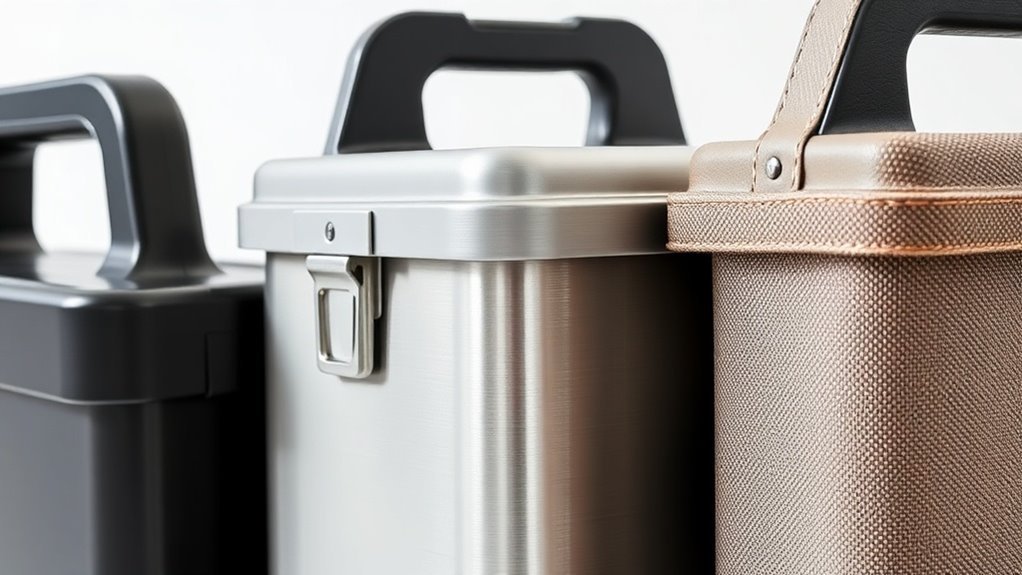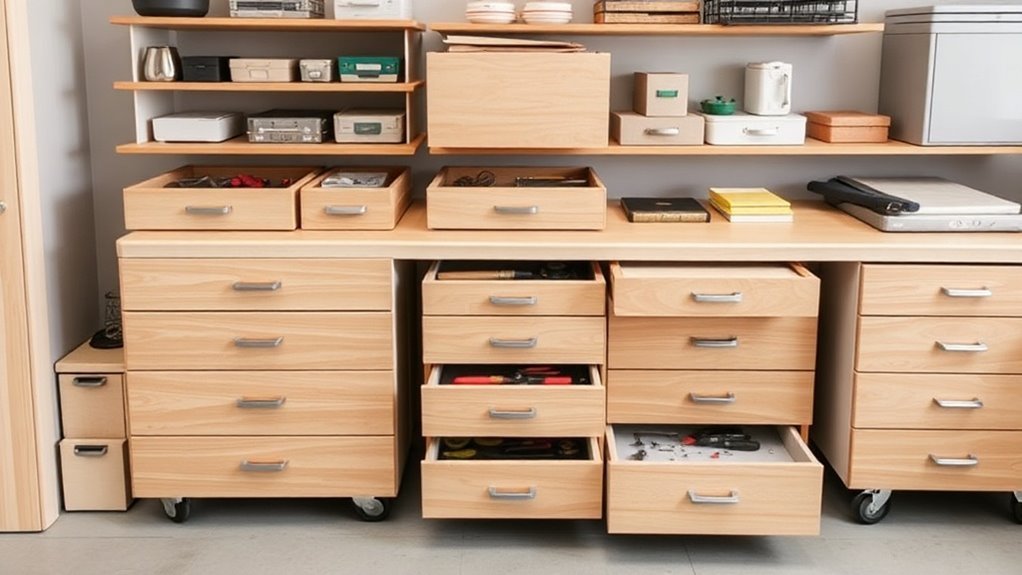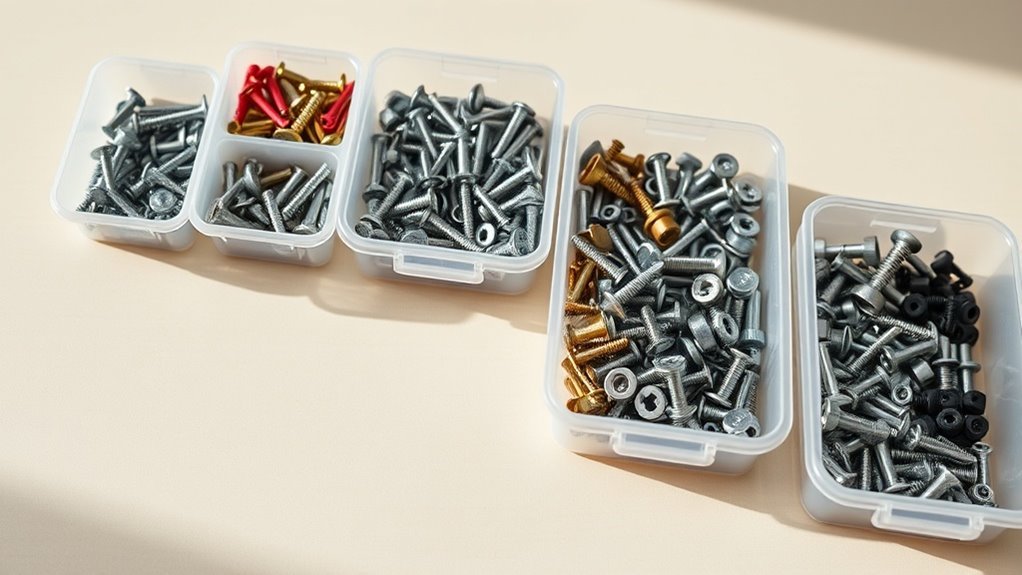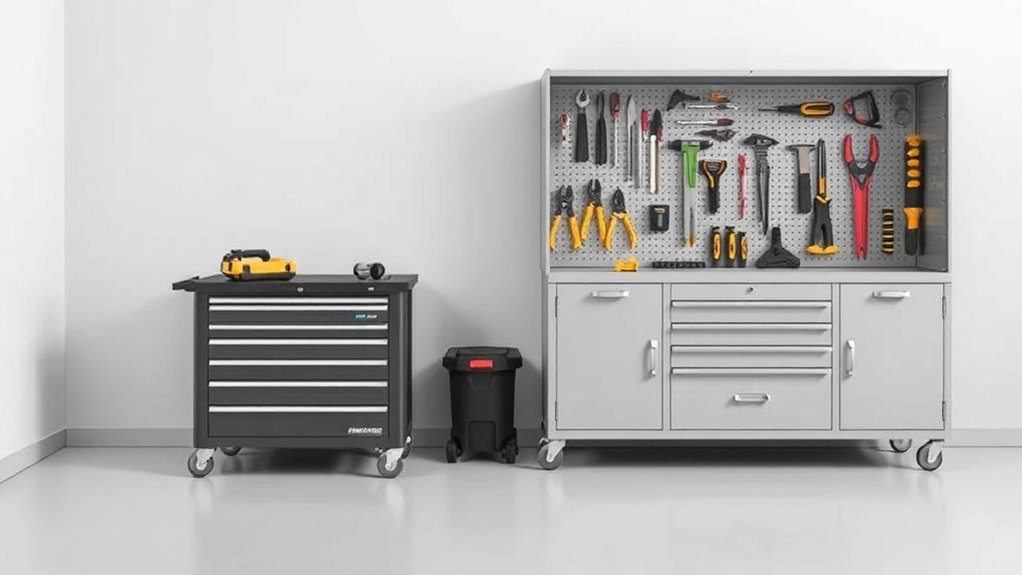Principles of Organizing Tools for Maximum Efficiency
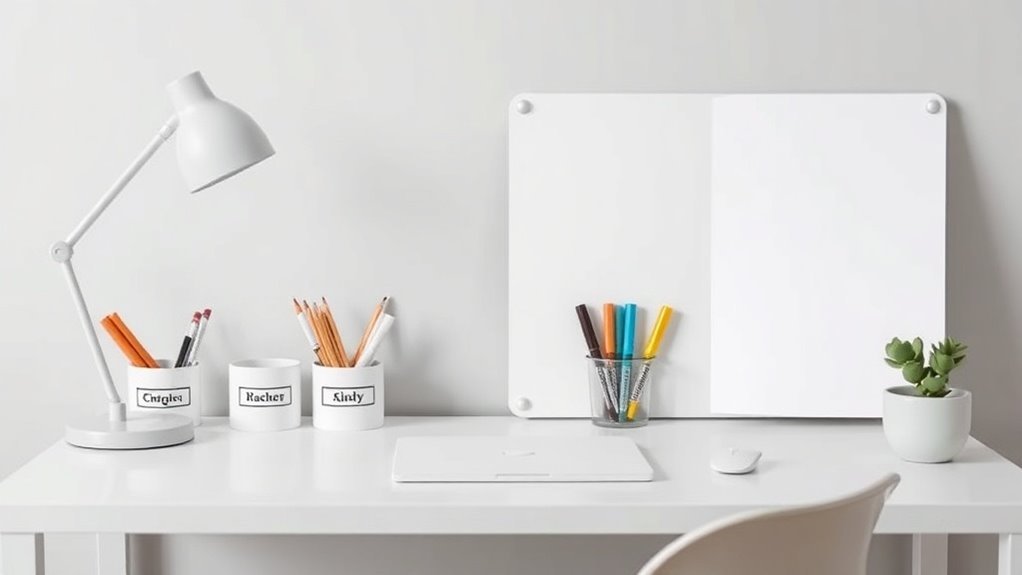
To organize tools for maximum efficiency, start by evaluating your needs and goals. Declutter by keeping only essential items while discarding duplicates and unused tools. Categorize your tools for easy access, using distinct storage solutions based on materials and use frequency. Leverage digital organization systems to streamline workflows and enhance productivity. Incorporating labels and visual aids can further improve accessibility. If you’re curious about more strategies to maintain this organization, there’s plenty more to explore.
Key Takeaways
- Group tools into categories such as hand tools, power tools, and consumables for quicker access and enhanced organization.
- Store frequently used tools within easy reach while keeping less-used items in less accessible areas for improved efficiency.
- Utilize appropriate storage materials like plastic for lightweight items and metal for heavier tools to balance functionality and aesthetics.
- Implement a regular maintenance routine that includes inventory checks and organization assessments to ensure tools remain efficiently organized.
- Adapt organization strategies periodically to address changing needs and priorities, maintaining clarity in item placement and workflow efficiency.
Assessing Your Needs and Goals
Before diving into organizing tools, it’s vital to assess your needs and goals, as this foundational step will guide your choices effectively.
Start by reflecting on what areas of your life need organization—be it your workspace, home, or digital files. Are you seeking more efficiency in your daily routines or a clearer home environment?
Identify the specific challenges you face, like clutter or time management. Then, consider your goals: Do you want to save time, reduce stress, or create a more functional space?
Identify your challenges—clutter or time management—and clarify your goals: saving time, reducing stress, or enhancing functionality.
Prioritizing these will help you choose the right tools. Having a clear understanding of your needs and objectives will guarantee you invest in solutions that truly enhance your efficiency and meet your unique circumstances. Additionally, remember that categorizing tools based on frequency of use can significantly simplify your workspace.
Decluttering: The First Step to Organization

Having identified your needs and goals, the next step is decluttering, which is essential for creating an organized space. Start by evaluating what you truly need versus what you can let go of. Decluttering not only frees up physical space but also clears mental clutter, making it easier to focus on your goals.
Here’s a simple way to categorize items:
| Keep | Discard |
|---|---|
| Items you use daily | Broken or unused items |
| Things that inspire you | Duplicates |
| Sentimental items you cherish | Things that no longer fit your needs |
| Essentials for your goals | Items that cause stress |
Once you’ve decluttered, you’ll find organizing becomes much simpler and more intuitive. Implementing proper tool storage techniques is crucial to maintaining safety and efficiency within your workspace.
Categorizing Tools for Easy Access
One effective strategy for maximizing efficiency is to categorize your tools for easy access. When everything’s in its place, you won’t waste time hunting down what you need.
Start by identifying the primary types of tools you use, then group them accordingly. Here are four categories to take into account:
- Hand Tools: Wrenches, screwdrivers, hammers—keep these together for quick fixes.
- Power Tools: Store drills, saws, and sanders in a separate location for safety and convenience.
- Measuring Tools: Tape measures and squares should be easy to grab for precise work.
- Consumables: Group nails, screws, and adhesives so you can restock efficiently.
This organization will streamline your workflow, making every project smoother and faster. Additionally, consider using strategic tool placement to further enhance accessibility and organization within your workspace.
Leveraging Digital Organization Systems
While physical tools are essential, leveraging digital organization systems can greatly enhance your efficiency. Utilizing apps and software can streamline your workflow, allowing you to access your files and projects from anywhere.
Start by exploring task management platforms like Trello or Asana, which help you prioritize tasks and track progress. Cloud storage services, such as Google Drive or Dropbox, keep your documents organized and easily sharable.
Explore Trello or Asana to prioritize tasks and track progress, while Google Drive or Dropbox keeps your documents organized and shareable.
Don’t forget about calendar tools to schedule appointments and set reminders for deadlines. Integrating these digital systems into your daily routine can minimize clutter and save you valuable time.
Make certain you regularly evaluate and adjust your digital setup to guarantee it continues to meet your changing needs. Keep it simple, and you’ll stay organized.
Utilizing Labels and Visual Aids
Labels and visual aids can transform your organizational approach, making information retrieval intuitive. When you implement these tools effectively, you’ll streamline your workflow.
Here are some essential strategies:
- Color Code: Use different colors to categorize items, making it easier to spot what you need at a glance.
- Clear Labels: Verify labels are concise and descriptive, so you don’t waste time deciphering what’s inside drawers or folders.
- Visual Charts: Create flowcharts or diagrams that illustrate processes, helping you grasp complex information quickly.
- Symbols and Icons: Incorporate universally understood symbols for quick reference, reducing reliance on text.
Implementing a Maintenance Routine
To keep your organizing tools working efficiently, it’s essential to establish regular check-ups. You should also document your maintenance procedures to guarantee consistency. This way, you’ll stay on top of your system and prevent issues before they arise. Regular maintenance routines will help you enhance the longevity and effectiveness of your tools.
Establish Regular Check-ups
Establishing regular check-ups is essential for keeping your organizational system running smoothly, as it helps you identify potential issues before they escalate.
Here are four key components to include in your check-up routine:
- Inventory Review: Assess your tools and supplies. Are there any unnecessary items or duplicates?
- Organization Assessment: Check if your tools are easy to find and accessible.
- Time Audit: Evaluate how much time you spend using each tool. Is it efficient?
- Feedback Gathering: Collect your thoughts on what’s working and what isn’t.
Document Maintenance Procedures
Implementing a solid maintenance routine for your documents can greatly enhance your organizational efficiency.
Start by setting a schedule to review and update your files regularly, whether it’s weekly, monthly, or quarterly. During these sessions, delete outdated documents and reorganize any misplaced files. Utilize clear labeling systems for ease of access, and make certain that everyone on your team understands and follows the protocols.
Consider using document management software to automate reminders for routine checks. This not only saves you time but also helps maintain consistency.
Don’t forget to back up important documents to prevent loss.
Selecting the Right Storage Solutions
When selecting the right storage solutions, start by evaluating your space needs to guarantee your choices fit well.
Next, identify item categories to streamline what you’ll store and where.
Finally, choose material types that match both your items and aesthetic preferences for a functional and appealing setup. Additionally, consider how modular storage systems can provide the flexibility and scalability needed for evolving workspace demands.
Assess Your Space Needs
How do you know what storage solutions are right for your space? Start by examining your space needs to find the perfect fit.
Here are four key steps to help you evaluate:
- Measure Your Area: Take precise measurements of your space to avoid overcrowding.
- Identify Usage Areas: Pinpoint high-traffic locations for quick access and designate storage accordingly.
- Consider Accessibility: Confirm that solutions allow easy access to frequently used items while keeping less-used items stored away.
- Evaluate Style and Aesthetics: Choose solutions that match your décor and personal style, creating harmony throughout the space.
Identify Item Categories
To maximize efficiency in your organizing efforts, it’s essential to identify item categories that will determine the most suitable storage solutions. By distinguishing what you’re organizing, you can streamline your process and enhance accessibility. Here’s a quick breakdown to help you:
| Category | Examples | Best Storage Solution |
|---|---|---|
| Office Supplies | Pens, paper, staplers | Drawer organizers |
| Kitchen Items | Pots, utensils, spices | Shelving racks |
| Seasonal Decor | Ornaments, lights, wreaths | Clear bins |
| Personal Items | Clothes, shoes, accessories | Baskets or closet bins |
| Tools and Hardware | Hammers, nails, screws | Toolboxes or pegboards |
Categorizing helps you find the right storage options, boosting your organizational input. Focus on clarity, and you’ll create an organized, efficient space.
Choose Material Types
Selecting the right materials for your storage solutions can make a world of difference in organization and longevity.
When you pick appropriate materials, you’ll not only enhance aesthetics but also improve functionality.
Here are four key material types to take into account for your storage needs:
- Plastic – Lightweight and moisture-resistant, great for various items.
- Metal – Durable and strong, ideal for heavier tools or equipment.
- Wood – Offers a classic look and sturdy structure, perfect for decorative storage.
- Fabric – Flexible and lightweight, suits soft items like clothes or linens.
Mapping Out a Workflow Process
While effective workflow mapping can feel overwhelming, it’s crucial for streamlining processes and enhancing productivity. Start by identifying your key tasks, then outline each step involved, no matter how small.
Visual aids like flowcharts can help you see connections and sequences clearly. Use different colors or shapes to categorize tasks by priority or department. Make certain to include decision points; they’re essential for the overall flow.
After mapping, review your workflow for bottlenecks or inefficiencies that might hinder progress. Don’t forget to seek feedback from team members; their insights can lead to valuable improvements. Incorporating efficient storage solutions can further enhance your organization and minimize clutter.
Finally, refine your workflow regularly to keep it aligned with your goals and maintain ongoing efficiency. Trust the process—it’ll make your life easier!
Adapting Organization Strategies Over Time
As your work environment changes, it’s essential to adjust your organization strategies accordingly.
Keeping up with evolving methods and new technologies can greatly boost your efficiency.
Evolution of Organizational Methods
Organizational methods have evolved considerably over the years, showcasing how adapting strategies can lead to increased efficiency and productivity.
As you navigate through these changes, consider these key developments:
- Categorization: Early strategies focused on sorting items into categories, giving you clarity on where things belong.
- Prioritization: As demands grew, prioritizing tasks became essential, helping you focus on what matters most.
- Standardization: Creating consistent processes guaranteed everyone could follow the same organizational methods, fostering teamwork.
- Flexibility: The modern approach emphasizes adaptability, allowing you to tweak your systems based on current needs and preferences.
Technology and Tool Adaptation
In today’s fast-paced world, adapting your organizational strategies to include technology can considerably enhance your efficiency. Embracing tools like project management software and digital calendars helps streamline your workflow, making collaboration and scheduling simpler.
Stay flexible by regularly evaluating these tools; they’re constantly evolving, and what worked yesterday may not suit your needs today. Don’t hesitate to experiment with new applications that automate repetitive tasks, freeing up valuable time for more critical activities.
Integrating cloud storage guarantees easy access to files from anywhere, promoting a seamless shift between workspaces. Ultimately, by embracing tech innovations and remaining open to adjustments, you’ll not only stay organized, but also be better equipped to meet the demands of an ever-changing environment.
Training Your Mind for an Organized Approach
Training your mind for an organized approach is essential for achieving maximum efficiency. By adopting clear, structured habits, you can streamline your processes and enhance productivity.
Here’s how you can get started:
- Set Clear Goals: Define what you want to achieve; this provides direction.
- Prioritize Tasks: Use a list to identify high-impact tasks; tackle them first.
- Practice Mindfulness: Regularly check in with your thoughts to maintain focus and reduce distractions.
- Review and Adjust: Periodically assess your organizational strategies; make changes as needed to improve efficiency.
Questions
How Can I Avoid Relapsing Into Disorganization After Organizing?
To avoid relapsing into disorganization, establish consistent routines, set reminders for upkeep, and periodically assess your system. Remember, small daily habits can create lasting change, so stay proactive and adapt as needed.
What Are Common Mistakes During the Organizing Process?
You’re likely skipping planning, underestimating time required, or failing to categorize items properly. These common mistakes can lead to frustration and disorganization, making it harder to maintain a tidy, efficient space in the long run.
Can I Organize Tools Without Spending Money?
Yes, you can organize tools without spending money. Use boxes, containers, or shelves you already have. Repurpose items like jars or old crates to keep everything tidy and easily accessible. Creativity’s key here!
How Often Should I Reassess My Organizational System?
You should reassess your organizational system every few months or whenever you notice clutter or inefficiency. Regular check-ins help you adapt and guarantee your tools remain accessible and functional, making your tasks smoother and easier.
Are There Specific Tools Ideal for Small Spaces?
Yes, compact storage bins, wall-mounted shelves, and multi-functional furniture are perfect for small spaces. Utilizing vertical space and hidden compartments can maximize storage while keeping your area organized and clutter-free, making the most of every inch.
Conclusion
In organizing your tools for maximum efficiency, remember that just like a well-tuned instrument, each element in your system should work harmoniously together. By evaluating your needs, decluttering, and implementing smart storage and digital solutions, you’ll create a streamlined workflow that enhances your productivity. Don’t forget to adapt your strategies as your circumstances change, and with practice, you’ll train your mind to embrace an organized approach that sets you on the path to success.

